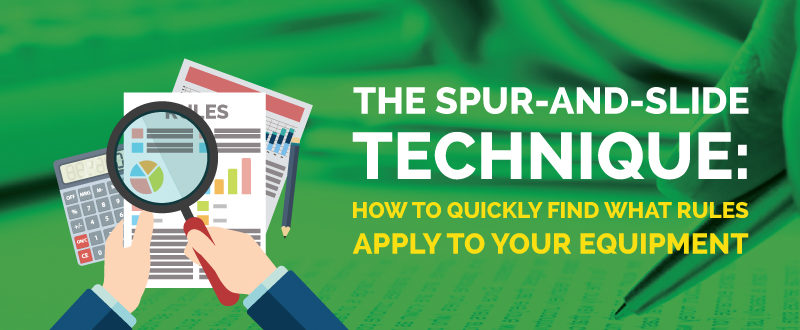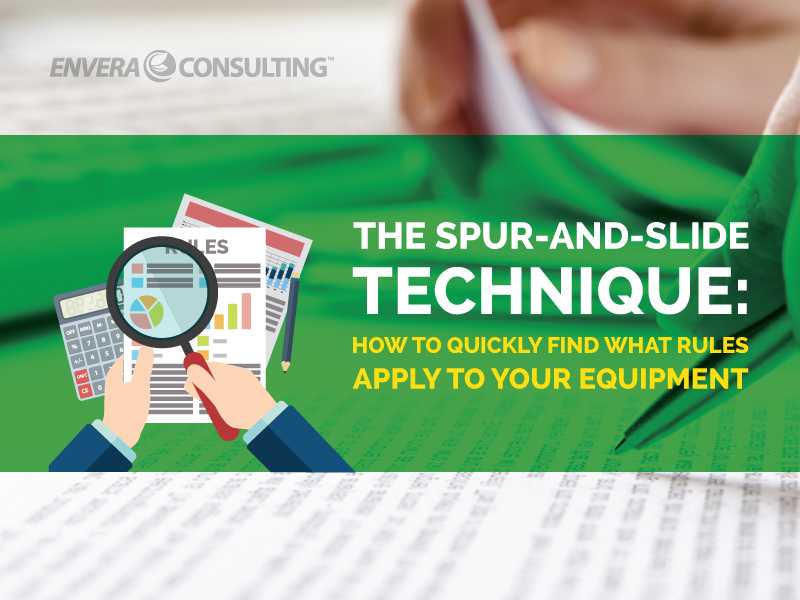

The SCAQMD has a whopping 325 different rules.
For any practicing air-quality professional, one primary responsibility is being able to quickly identify which of these many rules — and there’s often more than one — apply to a specific piece of equipment.
And that’s one of the most common gripes I hear from my clients: “How the heck am I supposed to weed through 325 rules to find the ones that apply?”
One of the reasons people get stuck when working with the rules is that they simply get overwhelmed — both with the sheer magnitude of rules and the amount of text in each one.
The trick to working with the rules is to skim. I know that sounds counterintuitive given that the rules contain very specific details about what you can and cannot do, but trust me on this. I’ve got your back.
The Spur-and-Slide Technique
At Envera, we’ve developed a technique that allows us to skim at scale. We call it the “spur-and-slide” technique. Here’s the backstory behind the name:
Imagine yourself at the top of one of those ginormous slides they have at fairs. When you go down the slide, potential energy is converted to kinetic, and you just slide down without stopping. Kind of like these pandas:
Now imagine that, as you go down the slide, you pass by different objects and people. Because of your speed, you take notice of some (bamboo, if you’re a panda) but ignore others. The ones you choose to notice are the spurs — little bumps that make you sit up and take notice.
Now pretend the rules are the slide and you are your finger. Simply scan down the titles of the rules and take note of any that you think might apply. The key here is to quickly use the title of each rule to make your determination.
Spur-and-slide is the opposite approach to what most people do. Folks usually get caught up in the details of each rule, causing them to lose sight of their end goal.
The benefits of the spur-and-slide technique are:
- You won’t get bogged down with the seemingly endless amount of words and pages that are found when working with the SCAQMD’s rules.
- You’ll have a system that you can use to work with the rules at scale.
- You can repeat the process — either using the whole rulebook or just a specific section, depending on where you are in the process — to refine your results.
The spur-and-slide technique typically works best with Regulations IV, XI, and XIV, because those are the command-and-control rules that state what needs to be done to keep a specific piece of equipment in compliance.
Applying the Technique to the Rules
When doing the spur-and-slide technique, you’ll need:
- Access to the SCAQMD rulebook (typically on a computer)
- A notepad and pen
- General details about the equipment that you’re researching about (type, fuel consumed, rating, etc.)
- General details about the process that you’re researching (wastewater plant, coffee roasting, internal combustion engines, etc.)
Let’s run down the four-step process.
Step 1: Quickly scan the SCAQMD’s rules and write down any rule that may apply to your equipment based on the title alone.
The titles of the SCAQMD’s rules are quite descriptive, and you’re using that to your advantage in this exercise. So just scan the titles. If you were using a computer, for example, you would go to one of the regulation pages with all the rules listed, like the one for Regulation I. Don’t dig deeper into the rule. Don’t get bogged down in the details. If you think there’s any chance the rule might apply, just write it down and keep sliding.
Step 2: Create your short list.
Once you have your short list of rules from the first part of the exercise, read through each rule on the list to see if the rule applies to your process. Because the rules are highly contextual, you’ll need to know some information about your process and equipment (points 3 and 4 in your materials above) in order to fully know if a certain rule applies.
Most people are apprehensive about reviewing any given SCAQMD rule. And that’s because each rule reads like a radio manual and is full of technical jargon and legalese.
The good news is that once you know which rules apply, your short list will become even shorter.
Step 3: Review the applicability and exemption sections from the rules in your short list to eliminate any rules that do not apply to your situation.
Since we’re only looking for the rules that apply, we only need to look at two sections in each rule: Applicability and Exemptions. These sections, which tend to be on the first and last pages of each rule, are important since there may be cases where a specific rule applies only if the equipment is over a certain size or was installed during a certain time frame.
In addition, there may be cases where the first part of the rule might make it seem as if your piece of equipment is subject to a rule, but an exemption removes the applicability. Let me give you an example.
Say you have a 200-brake-horsepower diesel-fired emergency generator that has a permit condition that states it can only be operated for no more than 200 hours in any one year.
During the spur-and-slide technique, you should have put Rule 1110.2 on your short list, since its title is “Emissions From Gaseous- and Liquid-Filled Engines” and you have a liquid-fueled engine. And under section (b), Applicability, you see that the rule applies to engines that are greater than 50 brake horsepower.
So at this point, all things point to your engine being subject to Rule 1110.2.
However, if you then take a gander at the Exemptions section, specifically (i)(1)(B), you’ll find that engines that have a permit condition limiting the operation to no more than 200 hours per year are exempt from this rule. On your list, make a note next to the rule as to why you are removing it, noting the exact page and section that caused you to make that determination.
So you’re off the hook: Your engine is not subject to Rule 1110.2. Which is great news, since the rule is a sleep-inducing 39 pages. If you hadn’t looked at the exemptions, you probably would be asleep somewhere around the time they started talking about compliance rules for a stationary engine with a CEMS.
Step 4: Review your shortened short list to ensure you’ve excluded the correct rules.
As with any task, you should always check your work, so make sure to confirm that you’re removing the correct rules. Be sure that you’re considering as much context as possible to make an informed decision as to why you’re removing a certain rule.
You can do this by reviewing the notes that you’ve created detailing the reasons why you’ve decided to remove a certain rule, but be aware that there could be gray areas that you’ll need to address.
Step 5: Repeat as many times as needed to pare back your list.
If there is one thing that is beneficial to using the spur-and-slide technique, it’s that your list is bound to get better and more accurate the more times that you rinse and repeat.
Also, your list is going to get more accurate the more people you involve in the process of scanning and generating your short lists, which you can then compare amongst each other. You never know: One of you may catch something the other missed.